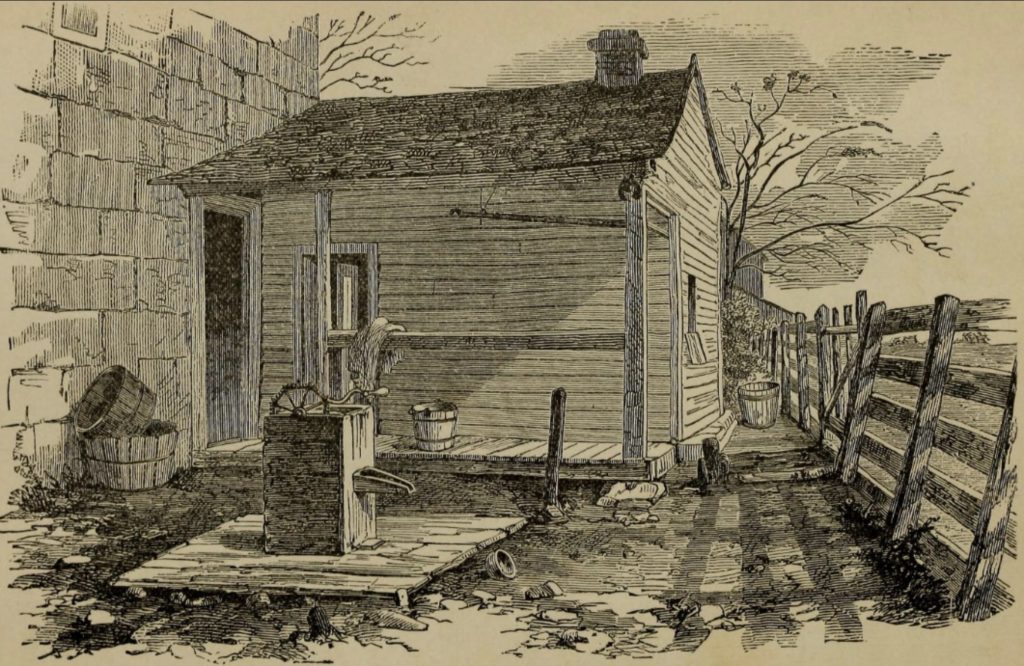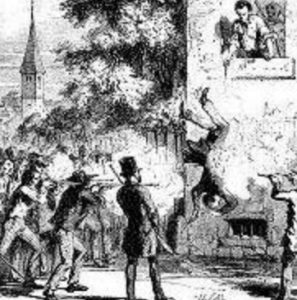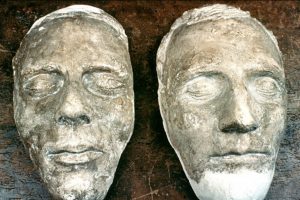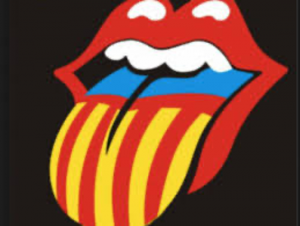He’d had this dread for a while. He knew what he was doing was frowned upon. Every day that he continued with his faith publicly, he was only deepening the target placed on his back. It was practically carved into him at this point. He knew the time was near. They had pushed the limits for too long. It was only through overhearing Hyrum’s prayers that he learned of it. His brother too felt the end nearing. When the shooting started, surprise was the last emotion he felt.
In Smith’s opinion, he was a fine mayor. He loved the people of Nauvoo and dedicated himself both physically and spiritually to being both their mayor and connector to the divine.1 People disagreed that he should be allowed to serve as mayor while also being the church’s living prophet.2 Smith was aware of the growing tensions within the community. Discussions of his authority often ended in town-wide brawls. It wasn’t unusual for him to be rushed to a ‘’safe’’ location in the middle of the night. At a certain point, he stopped questioning where they were taking him, or why. He did wonder why it all had to be handled so violently. Nonetheless, he knew that what he was doing would enrage those whose eyes had been closed for too long; but they were better because of it. Nothing could stop him on this god-given path he chose to take.3
When the Nauvoo Expositor began criticizing him, there was only one route of action he could take.4 The talk of the town and a couple of brawls over his position was one thing, but a newspaper publicly berating him and his message was going too far. As mayor and servant of God, he would not stand to have any articles published in opposition to him. That was a direct threat to his authority as well as the very stability of the Mormon community. Smith could not let the possibility of his followers being swayed by heretical discourse become a reality. Disbanding the newspaper was inevitable.5
The reactions were outrageous. Uncontrolled, vicious protests were nearly immediate after the disbanding. Smith was used to the death threats, and the vulgar gestures thrown his way. He was completely desensitized to the pure evil aimed at him. He had his eyes locked on God, and he knew what the real goal was. When the people of Nauvoo started taking legal action against him, that was something he was not prepared for. People far and wide have attacked him with things he always deemed subjective. They relentlessly disagreed with him on nearly every aspect of his faith, but it was never anything that went up against the law. He was mayor, after all; he was the law. They claimed his disbanding of the Nauvoo Expositor infringed on their First Amendment rights. Never mind the article was crafted by ex-members of the church with a personal vendetta against Smith’s polygamy doctrines. They were entitled to express their opinion in whatever way they saw fit, including a newspaper publication. The immediate dissatisfaction the town was brought upon following the press’s dismantling caught the attention of the state’s governor, Thomas Ford. The name of Joseph Smith was not one governor Ford was unfamiliar with. Many incidents of chaos within the town of Nauvoo had been brought to his attention in recent years. Though a staunch believer of anti-Mormon sentiments, Ford’s priority was always to keep the peace within the state. He took it upon himself to negotiate terms with Smith, to mitigate the disorder in Nauvoo, and most importantly, to uphold the integrity of the law.6

Smith’s followers were terrified. Carthage jail was inhabited by predominately anti-Mormons. They were not just people who didn’t believe in the movement but were people who were actively against it. Followers of Smith vocalized doubts about whether he should turn himself in to the law. They worried for his physical safety in the jail, as well as the condition the church would be in once he was captive. All of these thoughts were shared by Smith. He didn’t want to go to jail.7
Extremely hesitant and frightened, he explained to Governor Ford that he would not be safe in this jail, and that turning himself in would not just be his surrendering to the law, but to his death.8 Ford gave Smith the promise of safety, and with that comforting vow, Smith ultimately left his position as mayor of Nauvoo and submitted himself to the authorities.9
He could not wrap his mind around the disrespect he was now being shown. Being shuffled along like cattle with little disregard for who he was or the title he held only hours ago, was baffling. It was little comfort to be alongside his brother, Hyrum. Smith felt remorse for the trouble he had gotten him into. Being led into the jail, Smith noted the thick and heavy stone walls. He wondered what horrible people had walked this same path before him. He prayed for their salvation, as well as his own safety. A prominent, destined-for-glory man walked into this jail like a scared boy who was led to a dimly lit, constricting, and humid jail cell. It was a far cry from the spacious and expansive surroundings of Nauvoo. He no longer held the reins of power. This would take some time to get used to.10
He was subsequently charged with inciting a riot. Though not as bad a charge as he was expecting, Smith figured the public would wring out the damp washcloth that was the justice system to get every last drop of punishment placed upon him. The charge only lasted so long. The authorities, completely overwhelmed with the public’s outcry of distaste for Smith, were practically bullied into adding additional charges against him. One thing led to another, and now Smith was being faced with inciting a riot as well as treason, a charge that grew the pit in his stomach even larger than it already was, if that is even possible. This is where the dread began.11
There was little to do in the cell. Even surrounded by his closest allies, his brother Hyrum, and most loyal companions John Taylor and Willard Richards, Smith was lost. He was used to leading, and he’d grown accustomed to being the one entrusted with making decisions. His power was striped away, and now laid on the other side of the solid iron bars set before him. All he could was pray. That was the only solid seeming foundation he had. So that’s what he did. Day after day, Smith led his brother and friends in prayer; they sang hymns and studied sacred scripture.12 It was unusual to not have his usual crowd of followers, but staying true to his faith while in captivity made Smith feel closer to them. Whispers of armed mobs weighed heavily on Smith. He was aware that in the position he was now in, they held his life in their hands.
Smith had only surrendered to the authorities because of Governor Ford’s promise of protection. It was promised that Smith would be looked out for while awaiting his trial. It was only days ago now that Ford left the jail, unable to take the public’s scrutiny any longer. Smith was alone, utterly alone. His jailers were sympathetic to anti-Mormon propaganda, and he knew if the mob came knocking, they would do little to protect him. Smith turned his eyes towards God and attempted to find the meaning of it all. He was met with silence. Smith was freighted; he knew what was coming.13
The meager space of his cell only aided in the intimacy of the conversations shared within it. Smith kept a calm demeanor, despite the emotional turmoil he struggled with deep inside. He shared his anxiety openly with his brother and allies, but kept his strong front up to prevent them from worrying as well. Making amends and creating plans for the church, Smith tried to close every last door before he went face to face with the physical manifestation of the festering dread within him.14
Late one night, after talks of martyrdom and the future of the church, ominous noises halted Smith in his prayer. Unbeknownst to him, an armed mob of around two hundred men 15 were making their way to the jail, some already there and waiting for the signal to go. Clad with many different types of weapons, there was only one intent, one target. 16
As the mob breached the building and made their way up the stairs, they fired indiscriminately into the various rooms they came to. Hearing the gunshots and realizing now was the time, Smith and his allies quickly moved to action. Their options, considering their small empty cell, were limited. All four men pushed themselves against the door, using their full weight as a barricade. The mob, now on the opposite side of the door, had a greater force. Smith realized they only had mere minutes before their flimsy “protection” was gone. He had been thinking of this exact situation for a while now, anticipating it, dreading it. At a certain point, he could not handle not having an inch of control of the situation. After considerable negotiation with an open-minded guard, Smith was able to get a small revolver 17 smuggled in to him. Keeping it tucked in his waistband at all times, he contemplated when he would have to use it. He knew eventually he would have to, but this soon? Taking a step back from the barricade of men, Smith pulled the revolver from his belt. He didn’t have the time to register the shocked look on Hyrum’s face as he aimed the gun towards the wall and fired multiple rounds hoping, praying, that it would slow down the mob and spare them some time. The mob seemed to absorb the bullets, showing little slowdown or even impact from the gunshots. They pushed forward.18

Realizing there was little to do, Hyrum made a decision. Instructing the other men to shift the door to better help with coverage, little could be heard over the yelling and sounds of rustling feet from both sides. Hyrum realized this and shifted himself to better position the door. In doing this, a stray bullet made its way through the door and fatally into Hyrum’s skull.19
Watching his brother fall, Smith fell to his knees.20 This was a devastating blow to both Smith and the church. Hyrum was one of the first people to stand beside him with unwavering support as he took on his role of prophet. Now lying beside him, it was clear that this was the beginning of the end.21
With Hyrum dead, only three men remained. Smith realized that the cell was a death trap. It was never protection. The only slim possibility of survival they had was to get out of this room. With bullets flying left and right, and hands being punched through the door, Smith, Taylor, and Richards made their way to the window. Scrambling to reach the window that was multiple feet above their heads, Taylor caught bullets in both his thigh and hip. 22 Richards, helping to continue barricading the door while Hyrum lay dead, took up whatever position he could to help the two other men.23 Smith, not having the time to stop and register, climbed the wall. Standing atop the window, for a brief second Smith was able to see the sheer volume of men surrounding the jail. How did he end up here? A prophet of God? Servant of the one true living Christ? Why is it these men had such hatred in their hearts for him? In this idle moment, Smith caught bullets in both his front and backside, causing him to fall two stories to his death. This fall represented not only the end of Smith’s life but a closing chapter for the early Mormon church.24

As Smith’s lifeless body lay outside the jail, mob members gathered around him. Celebrating, they cheered and sang songs of victory. Particularly violent members attempted to decapitate him. Pure blood thirst controlled their actions, and at this point, there was no stopping them. It was only when other members of the mob stepped in that Smith’s body was left alone with what little dignity it had left. Left alone in one piece, it was a devastating blow for his followers. But in a way, he served as a sign of hope. A sign that even after all of the horrible persecution and abuse they had suffered, the church could too, prevail in one piece.
- Nauvoo, Illinois ↵
- The Church of Jesus Christ of Latter Day Saints, more popularly known as the Mormon church. ↵
- Joseph Smith, Jr, in Encyclopedia of Illinois History (Springfield, IL: Illinois State Historical Society, 2002), 4. ↵
- The Nauvoo Expositor was the town’s local newspaper. Established by former members of the church, including William Law, the paper openly criticized Smith’s authority, use of power, and teachings. These teachings specifically were pro-polygamy doctrines taught in private to higher members of the church. The ex-members disagreed with Smith’s antics, so they crafted and published what would be the first and only issue of the Nauvoo Expositor, openly criticizing Smith. Alex Beam, American Crucifixion: The Murder of Joseph Smith and the Fate of the Mormon Church (New York: Public Affairs, 2015), 115-116. ↵
- Not only was the Nauvoo Expositor disbanded, it was destroyed. After emergency meetings with Smith’s most inner circle, it was decided that the Expositor was a “public nuisance.” It was then ordered that the city marshal destroy the press. On June 10, 1844, the city marshal, alongside a few members of the police, went to the printing station to destroy the press. Scattering the type, burning any remaining papers of the Expositor, and smashing the physical press, the Nauvoo Expositor was no more. Alex Beam, American Crucifixion: The Murder of Joseph Smith and the Fate of the Mormon Church (New York: Public Affairs, 2015), 115-116. ↵
- Alex Beam, American Crucifixion: The Murder of Joseph Smith and the Fate of the Mormon Church (New York: Public Affairs, 2015), 145. ↵
- Fawn McKay Brodie, No man knows my history: The life of Joseph Smith, the Mormon prophet (New York: Vintage Books, 1995), 382-385. ↵
- Joseph Smith, Jr, in Encyclopedia of Illinois History (Springfield, IL: Illinois State Historical Society, 2002), 4. ↵
- Smith attempted to flee Nauvoo before he surrendered to the arrest. Bringing his brother Hyrum with him, they went as far as the Mississippi River before deciding to turn back. ↵
- Alex Beam, American Crucifixion: The Murder of Joseph Smith and the Fate of the Mormon Church (New York: Public Affairs, 2015), 158-160. ↵
- Joseph Smith, Jr, in Encyclopedia of Illinois History (Springfield, IL: Illinois State Historical Society, 2002), 3. ↵
- Alex Beam, American Crucifixion: The Murder of Joseph Smith and the Fate of the Mormon Church (New York: Public Affairs, 2015), 160. ↵
- Alex Beam, American Crucifixion: The Murder of Joseph Smith and the Fate of the Mormon Church (New York: Public Affairs, 2015), 172 ↵
- Fawn McKay Brodie, No Man Knows My History: The Life of Joseph Smith, the Mormon Prophet (New York: Vintage Books, 1995), 353. ↵
- The men of the mob were all masked, purposefully concealing their identities. It is still to do this day unknown who those men actually were ↵
- Alex Beam, American Crucifixion: The Murder of Joseph Smith and the Fate of the Mormon Church (New York: Public Affairs, 2015), 180-183. ↵
- To be more specific, a small, “pepper box” revolver ↵
- Alex Beam, American Crucifixion: The Murder of Joseph Smith and the Fate of the Mormon Church (New York: Public Affairs, 2015), 180-183. ↵
- Fawn McKay Brodie, No Man Knows My History: The Life of Joseph Smith, the Mormon Prophet (New York: Vintage Books, 1995), 392-393. ↵
- Smith’s last words to Hyrum in this moment were, “Oh, dear brother Hyrum!” ↵
- Alex Beam, American Crucifixion: The Murder of Joseph Smith and the Fate of the Mormon Church (New York: Public Affairs, 2015), 179. ↵
- John Taylor would eventually make it out of the jail, severely wounded but alive. He would go on to become the church’s third president. His first-hand account of the incident helped to keep Smith’s legacy alive. Alex Beam, American Crucifixion: The Murder of Joseph Smith and the Fate of the Mormon Church (New York: Public Affairs, 2015), 179. ↵
- Richards would go on to be the only man in this attack to make it out completely unharmed. After the mob was gone he tended to Taylor’s wounds and helped to transport him back to Nauvoo. He famously attributed his making it out unharmed to his larger size. Not a single bullet touched him. His first-hand account helped to validate this event in history. Alex Beam, American Crucifixion: The Murder of Joseph Smith and the Fate of the Mormon Church (New York: Public Affairs, 2015), 179. ↵
- Richard Lyman Bushman, Joseph Smith: Rough Stone Rolling (New York: Knopf, 2005), 215-218. ↵




10 comments
arosales11
This piece eloquently details Joseph Smith’s last days, exposing the fierce rivalry that surrounded his leadership. I was able to obtain more facts of the intricate conflicts in Nauvoo and the difficulties Smith encountered due to contentious actions. Particularly moving was the thorough description of his murder at Carthage Jail, which revealed his anguish and the terrible events that led to his demise.
Natalia De la garza
This infographic is excellent! It clearly explains the challenges Joseph Smith faced as both a religious leader and mayor of Nauvoo, including the tensions that led to the suppression of the Nauvoo Expositor and his eventual assassination.
Danielle Villanueva
Wow! This article vividly describes Joseph Smith’s final days, revealing the intense conflict surrounding his leadership. I learned about the complex tensions in Nauvoo and the challenges Smith faced with controversial practices. The detailed account of his murder at Carthage Jail was particularly powerful, showing his turmoil and the tragic circumstances leading to his death. The writing brings history to life with emotional depth.
Cesia Gonzalez
I enjoyed reading your article! It was really interesting and informative. Your piece has a beautiful flow, and I love how you portray this story, you’ve captured the emotional and historical significance beautifully.
Deirdre
An easy going and informative read, with emphasis on “telling the story”; not just the authors own views. I learned something new today…and I thank you!
Big Al
I didn’t read it I just wanted to leave a comment
Susan Leffler-Kitchen
Nice article! Knew some of it, but not near as much as what you wrote about. I need to have you write the stories of our families’ historys!
Emmett Pizzoferrato
That was quite a ride .. I knew a bit about the Mormon church, but not about it history. Excellent story thanks so much for sharing it too much talent in my family. Not….
Justin
Fantastic article! I really enjoyed the dichotomy of the two points of view. Contrasting both points of view provides an entertaining read that is also informative without an overt bias. Great job!
Katrina
Beautiful, well written article. Love the compare/contrast approach to this. Very well researched! Great job!